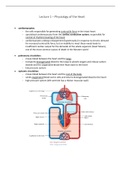Lecture 1 – Physiology of the Heart
cardiomyocytes:
the cells responsible for generating contractile force in the intact heart
specialized cardiomyocytes form the cardiac conduction system, responsible for
control of rhythmic beating of the heart
cardiomyocytes undergo enlargement (hypertrophy) in response to chronic demand
for increased contractile force, but an inability to meet these needs leads to
insufficient cardiac output for the demands of the whole organism (heart failure),
one of the most common causes of death in the Western world
pulmonary circulation:
moves blood between the heart and the lungs
transports deoxygenated blood to the lungs to absorb oxygen and release carbon
dioxide and the oxygenated blood then flows back to the heart
low pressure system
systemic circulation:
moves blood between the heart and the rest of the body
sends oxygenated blood out to cells and returns deoxygenated blood to the heart
high pressure system (left ventricle has a thicker muscular wall)
, functions of the heart:
pumps deoxygenated blood to the lungs
pumps oxygenated blood to all the organs in the body
together with blood vessels provides adequate perfusion of all organs & tissues of
the body
contraction and relaxation determine cardiac output
The conducting system of the heart
a network of specialized cardiac muscle cells, called pacemaker and conducting cells, that
initiates and distributes electrical impulses
automation of the heart:
the heart can beat independent of hormonal or neuronal input (autorhythmicity)
the heart is spontaneously active (due to pacemaker cells)
pacemaker cells (nodal cells):
essential for establishing the normal heart rate
can be found in the sinoatrial (SA) node (cardiac pacemaker) and the
atrioventricular (AV) node
conducting cells:
interconnect the SA and AV nodes and distribute the contractile stimulus
throughout the myocardium
in the atria, they can be found in internodal pathways
in the ventricles, they can be found in the atrioventricular (AV) bundle (the
bundle of His) and the bundle branches, as well as the Purkinje fibers
, pacemaker potential – each time a pacemaker cells repolarizes, its membrane potential
shifts toward threshold (gradual depolarization)
results from a slow inflow of Na + without a compensating outflow of K+
the rate of spontaneous depolarization differs in various parts of the conducting system
it is fastest at the SA node
isolated cells of the AV node depolarize more slowly
because the SA node reaches threshold first, it establishes the basic heart
rhythm, or sinus rhythm
, a number of clinical problems result from abnormal pacemaker function:
bradycardia – a condition in which the heart rate is slower than normal
tachycardia – a condition in which the heart rate is faster than normal
The action potential
,
,Heart rate
determined by:
resting membrane potential of SA node cells
velocity of depolarization: slope of the prepotential
the sympathetic nervous system (SNS) releases the hormones (catecholamines -
epinephrine and norepinephrine) to accelerate the heart rate
the parasympathetic nervous system (PNS) releases the hormone acetylcholine to slow the
heart rate
,Excitation-contraction coupling
contraction of the heart following electrical stimulation of cardiomyocytes
excitation-contraction coupling links electrical excitation of the cardiomyocyte cell
membrane (via an action potential) to actin-myosin cross-bridge cycling that results is the
cell’s contraction
excitation, contraction, and relaxation are all ATP-dependent processes
contraction of cardiomyocytes is dependent on rapid release of Ca 2+ from the sarcoplasmic
reticulum via the ryanodine receptor – calcium induced calcium release
relaxation of cardiomyocytes is dependent on the reuptake of Ca2+ back into the
sarcoplasmic reticulum via an ATP-dependent pump called SERCA
the autonomic nervous system, as well as proteins troponin, tropomyosin, and
phospholamban play key regulatory roles
,ECG
monitors the electrical events of the conducting system
measures the depolarization of the muscle
ECG signal reflects electrical differences between regions in the heart
performed according to Einthoven (I, II, III)
P wave: atria depolarize
QRS complex: ventricles depolarize, and atria repolarize
T wave: ventricles repolarize
the amount of depolarization during the P wave and the QRS complex is particularly
important in making a diagnosis
for example, an excessively large QRS complex often indicates that the heart has
become enlarged
a smaller-than-normal electrical signal may mean that the mass of the heart muscle
has decreased (although monitoring problems are more often responsible)
the size and shape of the T wave may also be affected by any condition that slows
ventricular repolarization
for example, starvation and low cardiac energy reserves, coronary ischemia
(inadequate blood flow to cardiac cells), or abnormal ion concentrations reduce the
size of the T wave
arrythmia – an irregularity in the normal rhythm or force of the heartbeat
serious arrhythmias may indicate damage to the myocardium, injuries to the
pacemaker cells or conducting cell pathways, exposure to drugs, or abnormalities in
the electrolyte composition of extracellular fluids
,The cardiac cycle
, blood flow through the heart is completely determined by pressure differences
1) passive filling
AV valves: open
aorta/pulmonary valve: closed
2) atrial kick
AV valves: open
aorta/pulmonary valves: closed
3) isovolumetric contraction
AV valves: closed
aorta/pulmonary valves: closed





